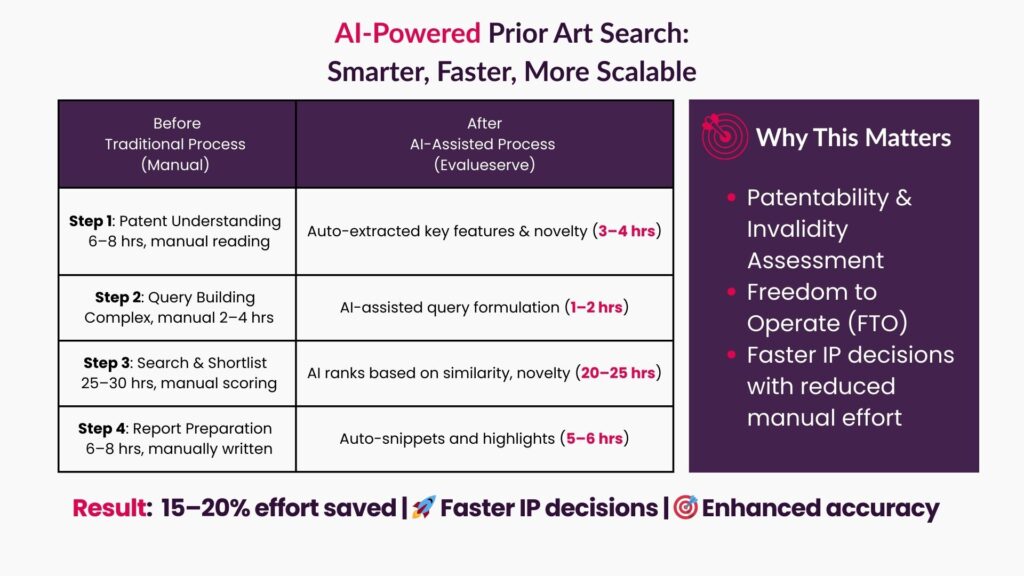What if the future of prior art search didn’t start with a keyword, but with a question?
Patent systems worldwide are facing unprecedented pressure. With the rapid growth of AI in patent search and over 245,000 AI-related patent applications filed globally in 2023, up from approximately 140,000 in 2019, search professionals and IP decision-makers are finding it more challenging than ever to track novelty, avoid overlap, and extract meaningful insight from a swelling sea of technical disclosures.
Adding to the complexity is the fact that China alone now accounts for nearly 70% of global AI patent filings, far outpacing the United States and Europe in sheer volume. These shifts signal more than just geographic trends. They reflect a new era of scale, speed, and strategic complexity in the patent ecosystem.
This evolution is being driven by artificial intelligence, which replaces rigid keyword logic with contextual understanding, making patent search more intuitive, comprehensive, and scalable.
The Traditional Prior Art Search Landscape
For decades, patent search has been a cornerstone of intellectual property strategy, yet one that is often slow, siloed, and susceptible to human limitations. Professionals rely heavily on structured databases, Boolean operators, and carefully crafted keyword combinations to uncover relevant prior art or assess white spaces in the market.
But the system is far from perfect.
- An Overwhelming Volume of Data: In 2023 alone, over 3.55 million patent applications were filed worldwide, adding to a cumulative total of more than 140 million active patent documents across global databases. This growing volume makes manual prior art search increasingly time-consuming and error-prone.
- The Limitations of Keyword Dependency: Traditional search tools rely on exact-match logic. A query for "neural networks" may miss patents using terms like "deep learning algorithms" or "artificial neural architectures", even when referring to similar technologies. In fast-evolving fields, terminology mismatches can result in incomplete or misleading search results.
- Siloed Classification Systems: Patent classification codes differ between jurisdictions (e.g., CPC vs. IPC), and inconsistent tagging within the same system is common. This fragmentation makes global searches difficult, especially when innovation crosses disciplinary or regional lines.
- Human Error and Cognitive Overload: Even experienced analysts struggle to maintain accuracy when reviewing hundreds or thousands of documents. Human fatigue, time pressure, and inherent biases can all contribute to missed references or false negatives, risks that can delay filings, weaken protection, or result in costly litigation.
AI in Prior Art Search: A New Reality
The limitations of traditional search methods aren’t just operational, they’re strategic. With the rapid expansion of patent filings and competitive claims, search teams need tools that cut through complexity and extract insight from nuance, ambiguity, and scale. As AI in patent search continues to mature, it enables IP teams to make faster, more accurate, and more strategic decisions.
From Keyword Matching to Semantic Understanding
AI, particularly natural language processing (NLP), enables semantic search, a method that understands the meaning behind a query rather than just matching specific terms. Instead of searching for “battery management system,” users can explore the concept itself, uncovering related patents that might use different technical language.
This shift significantly boosts both recall and precision, reducing the chance of missing key prior art while cutting through irrelevant noise.
Speed at Scale
AI algorithms can scan millions of documents in seconds, generating ranked results, highlighting novelty, and even identifying potential infringement risks. What used to take hours or days can now be achieved in minutes.
Some platforms report up to 80% reductions in search time when AI is integrated into patent workflows.
Multilingual and Multijurisdictional Reach
AI can automatically translate and interpret patents across languages and jurisdictions, leveling the playing field for global searches. A single query can uncover documents in Mandarin, Japanese, German, or French, parsed through AI’s contextual understanding, not just literal translation.
Smarter Classification and Clustering
Machine learning models can cluster patents by technology themes or use-cases, even when the documents aren’t tagged that way. This reveals white spaces, competitive threats, or emerging trends that traditional classification schemes might miss.
Continuous Learning and Improvement
Unlike rule-based search engines, AI systems improve over time. Feedback loops help refine relevance rankings, adapt to user behavior, and evolve alongside technological progress.

The Strategic Benefits of AI in Prior Art Search
AI in prior art search is elevating it from a routine process to a high-impact tool for strategic IP management. It empowers organizations to act earlier, file smarter, and compete more effectively in fast-moving markets. For instance, a global technology client working with Evalueserve IP and R&D reduced prior art search effort by 20-25% per case by integrating AI into their workflow. Patent understanding time dropped from 6-8 hours to 3-4 hours, and query-building time was cut nearly in half, translating into faster filings and better-aligned claim strategies across portfolios. By scaling this AI-assisted model across 1,000+ searches and 50+ clients, the approach delivered measurable efficiency gains and freed up IP analysts to focus on higher-value strategic tasks.
Beyond this single use case, AI in patent search delivers broader business value across the IP lifecycle:
- Targeted portfolio decisions: AI-driven clustering reveals under-leveraged patents and whitespace
- IP monetization pathways: Smarter prior art mapping highlights licensing and cross-licensing potential
- Lower legal spend: Faster, AI-curated results reduce outside counsel review time
- Strategic filing moves: Competitive intelligence from AI search informs jurisdiction and claim scope
These aren’t just theoretical gains. Around the world, patent authorities are validating this shift. In the U.S., the USPTO is piloting AI tools that deliver automatically generated prior art reports to examiners, highlighting the 10 most relevant documents for each application. As patent offices and legal teams adopt these tools at scale, the strategic advantage will shift to those who embed AI early in their IP workflows.

Proven Impact of AI-assisted Prior Art Search
But the real business value goes beyond speed. AI in prior art search reinforces those same priorities, reducing legal costs, enhancing filing quality, and turning IP into a source of strategic value. By reducing attorney review time and minimizing prosecution errors, AI also contributes to cost efficiency across the IP lifecycle. For enterprises managing hundreds or thousands of active assets, these gains can translate into millions saved and better alignment between IP portfolios and long-term business objectives.
Beyond Search: Time to Think Bigger
The role of prior art search is no longer limited to technical due diligence. With AI, it becomes a forward-looking tool for strategic IP management, competitive differentiation, and market visibility. As global patent activity accelerates, particularly in fields like generative AI, climate tech, and biocomputing, organizations relying solely on traditional methods risk falling behind in a landscape increasingly shaped by AI in patent search.
But what if this shift goes beyond improving how we search?
What if AI starts to reshape how we define novelty? Will patent offices begin to standardize AI-generated prior art reports? Could claim drafting evolve into a process guided by real-time, predictive search feedback? And what happens when AI not only informs IP strategy, but starts to challenge it?
These are no longer abstract hypotheticals. They’re decisions that IP leaders will need to confront sooner than expected. In a landscape where speed, clarity, and foresight determine market leadership, rethinking the role of search might be the boldest strategic move of all.
Talk to One of Our Experts
Get in touch today to find out about how Evalueserve can help you improve your processes, making you better, faster and more efficient.


